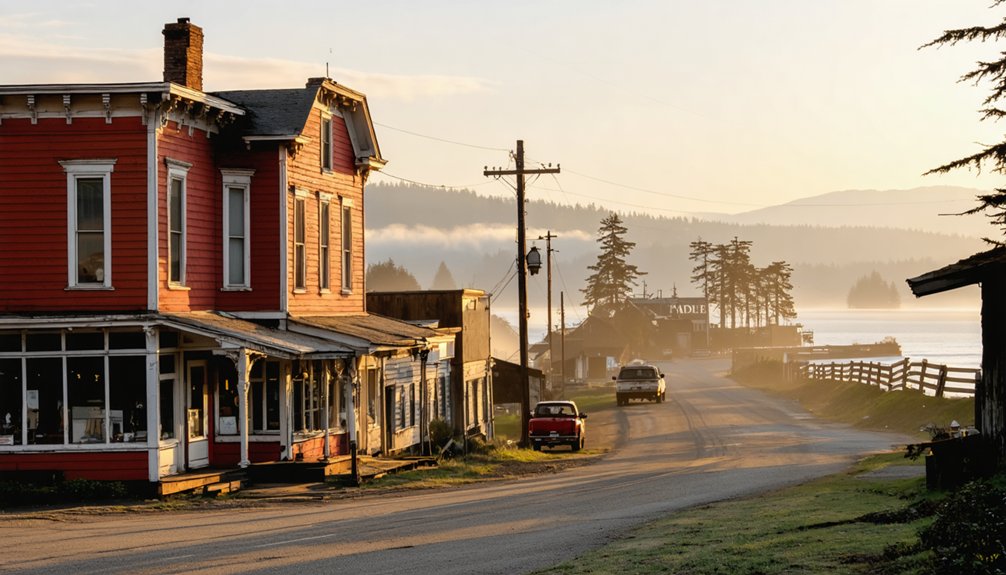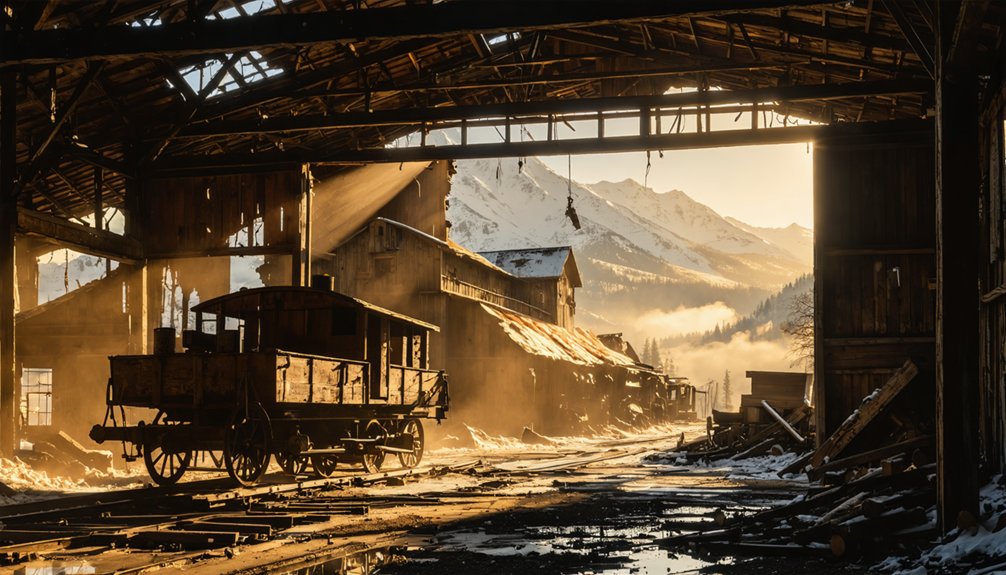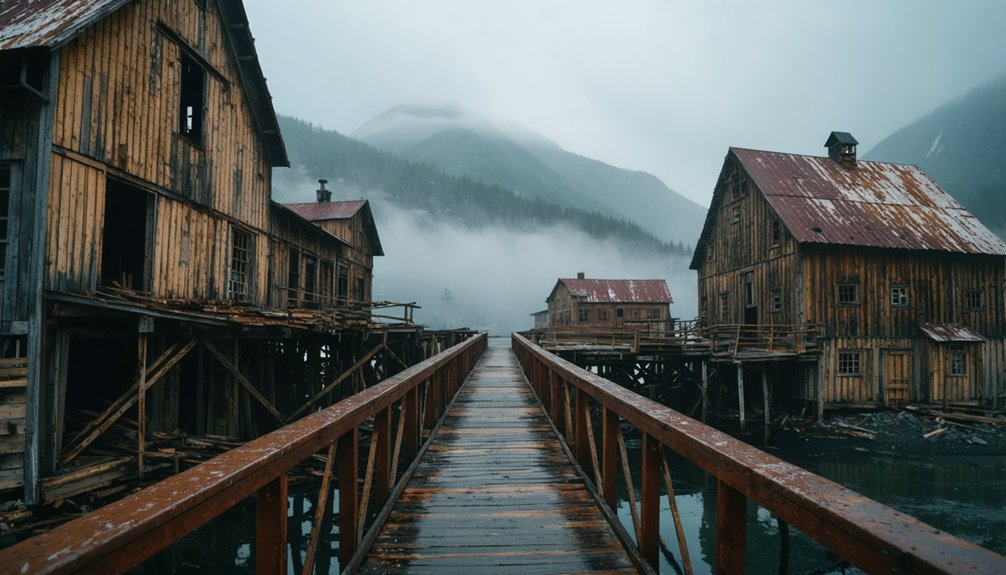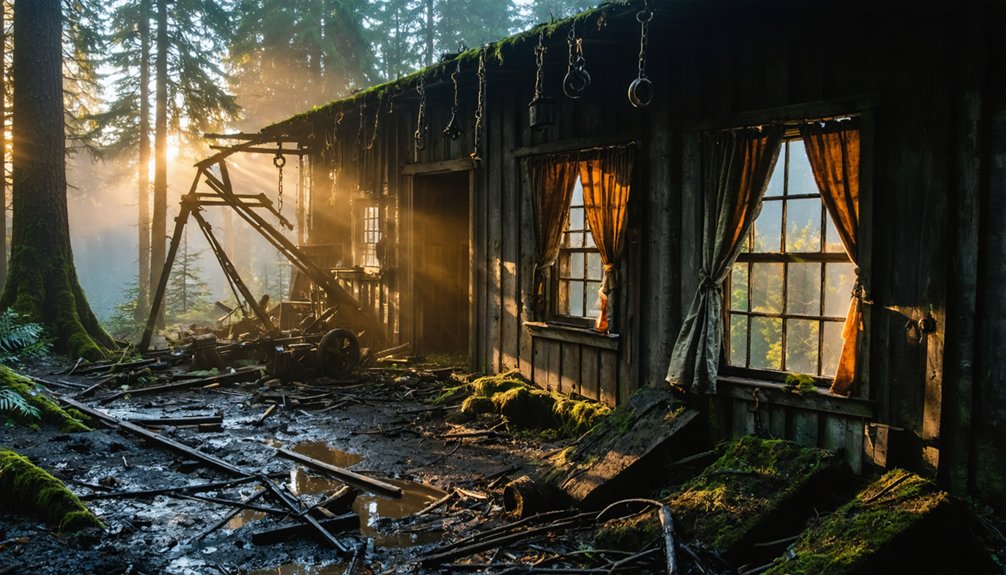Seven abandoned timber industry towns that tell America’s logging history include Port Gamble (Washington), Livermore and Zealand (New Hampshire), Kennecott (Alaska), Barthell (Kentucky), McCloud (California), and Glenrio (Oregon). Each community thrived during lumber booms before facing mill closures, natural disasters, or resource depletion. Today, you’ll find these places transformed into living museums, historic districts, or ghost towns reclaimed by nature. Their preserved buildings and artifacts reveal the deeper story of America’s industrial past.
Key Takeaways
- Port Gamble, Washington preserved its historic buildings after North America’s longest-running sawmill closed in 1995.
- Livermore, New Hampshire collapsed after its sawmill burned in 1920 and a devastating flood hit in 1927.
- Zealand, New Hampshire was abandoned by 1892 after resource depletion from aggressive clear-cutting and catastrophic fires.
- McCloud, California transitioned from a major lumber town processing 500,000 board feet daily to a heritage tourism site.
- Timber towns often became ghost towns due to resource depletion, natural disasters, mill closures, or economic shifts.
Port Gamble, Washington: The Company Town That Refused to Die

When you travel up the Kitsap Peninsula in Washington State, you’ll find Port Gamble standing as a remarkable tribute to America’s timber heritage. Founded in 1853 by Andrew Pope and Captain William Talbot, this purpose-built company town operated North America’s longest-running sawmill for 142 years until 1995.
At its peak, Port Gamble’s economic legacy was staggering—shipping 19 million board feet of lumber globally via its own fleet of 10 vessels.
The company created a self-contained community with housing, stores, schools, and churches for its 800 residents, many recruited from Maine under six-month contracts. Like Ryderwood, Port Gamble was established to provide loggers with a stable community environment rather than forcing them to live in isolated camps. Today, the town exudes nineteenth-century New England charm as a National Historic Landmark.
Unlike many abandoned timber towns, Port Gamble refused extinction. After the mill’s closure, preservation efforts transformed it into a living museum, with restored historic buildings celebrating its influential role in Washington’s industrial development.
Livermore, New Hampshire: A Village Reclaimed by the Forest
If you’d ventured to Livermore in its heyday, you would’ve found a bustling railroad-dependent community where timber traveled efficiently from forest to mill.
The town’s fortunes changed dramatically when the sawmill burned down in 1920, remaining inactive for two critical years while leadership faltered following the deaths of key Saunders family members.
This catastrophic pause in operations, combined with the devastating 1927 flood, sealed Livermore’s fate, transforming a once-thriving lumber center into the forest-reclaimed ghost town you’ll find today. At its peak, Livermore housed approximately 200 residents who relied on the logging industry for their livelihoods. Visitors can still discover the town’s remains via Sawyer River Road, approximately two miles from Route 302.
Railroad-Centered Logging Community
Hidden among the dense White Mountains of northern Grafton County, Livermore stands as a quintessential example of a railroad-centered logging community completely reclaimed by nature.
You’d find the town’s physical structure literally shaped by the rails—company buildings positioned strategically between the tracks and main road, creating distinct boundaries between commercial and residential areas.
The Sawyer River Railroad, extending eight miles into the forest, wasn’t merely transportation; it defined the community dynamics of this 150-200 person settlement. Like many operations in the region, the railroad utilized sturdy Baldwin locomotives for hauling timber through the challenging mountain terrain.
The logging techniques evolved around this critical infrastructure, with the railroad facilitating movement of timber to Conway and beyond.
Five boardinghouses accommodated transient workers, while established families occupied permanent residences, creating a balanced ecosystem of permanent and seasonal labor that supported the mill’s $44,000 annual production until its eventual abandonment in 1950.
The community faced significant challenges including a devastating smallpox epidemic and a destructive fire in 1919 that contributed to its eventual decline.
Mill Disaster’s Lasting Impact
The slow decline of Livermore, once a thriving railroad-centered community, began not with a whimper but with a series of catastrophic blows.
After Daniel Saunders’ death in 1917, leadership faltered under inexperienced management just as disaster struck—the 1919 fire decimated the mills, demanding costly reconstruction.
You can trace community resilience through their attempts to rebuild, but nature had other plans. Clinton Nash, a friend of the Saunders sisters with limited lumber knowledge, struggled to manage the mill operations during this critical period. By the 1930s, only 23 residents remained in this once vibrant logging village.
The historic 1927 flood destroyed the newly completed mill reconstruction and washed away crucial railroad infrastructure.
Population plummeted 76% in just one decade.
Kennecott, Alaska: Where Timber and Copper Created a Wilderness Boomtown
Nestled deep within what’s now Wrangell-St. Elias National Park, Kennecott stands as a symbol of America’s industrial ambition.
You’re looking at a wilderness boomtown where copper, not timber, fueled an extraordinary chapter of Kennecott history. Founded in 1903 through Guggenheim and Morgan interests, this remote operation conquered seemingly impossible terrain. Today, the remarkably preserved historic buildings attract visitors seeking to explore this ghost town’s past.
The Alaska Syndicate invested $25 million (over $730 million today) to establish this copper mining marvel, constructing a 196-mile railway through rugged wilderness. The mine ultimately produced approximately 4.6 million tons of copper ore before closing in 1938.
A wilderness empire forged through staggering investment, connecting America’s copper frontier to civilization against all odds.
At its peak, Kennecott employed hundreds, offering America’s highest mining wages within a self-contained community featuring everything from hospitals to tennis courts.
Barthell, Kentucky: The Coal-Timber Ghost Town Experience
When you visit Barthell’s restored company store, you’ll find authentic scrip tokens, ledgers, and merchandise displays that reveal the economic control exerted over coal-timber workers’ daily lives.
Beyond these artifacts, the carefully reconstructed miners’ cabins and bath house offer glimpses into the harsh realities of early 20th-century extraction laborers who balanced dangerous work with tight-knit community bonds.
The site’s partial restoration exemplifies the tension in ghost town preservation—between allowing nature’s reclamation process to continue and reconstructing enough physical history to maintain educational value for future generations.
Company Store Artifacts
Artifacts from the Barthell company store offer tangible connections to the daily economic life that once defined this Kentucky coal-timber community.
You’ll find remnants of an operation that wasn’t just retail—it was the beating heart of town commerce, reaching $1,000,000 in annual business by 1928.
The historical significance of these company store artifacts reveals how miners’ families lived and consumed. Original items range from safety equipment to Swift food products and Florsheim shoes.
The 1,600-square-foot two-story wooden structure housed not only merchandise but community services like the post office.
When you visit the restored Barthell site, reopened in 1999 after six years of preservation work, these artifacts illuminate how company stores functioned both as economic centers and subtle mechanisms of control through scrip-based credit systems.
Coal-Timber Worker Life
Beyond the walls of the company store, the daily rhythms of coal-timber life shaped Barthell’s character with unrelenting intensity.
You’d witness workers receiving scrip instead of cash, tethering their economic freedom to the very company extracting their labor—a subtle form of control amid overt labor struggles.
Despite these hardships, community resilience flourished. Families gathered at company-provided recreational spaces—baseball fields, theaters, even a golf course—creating bonds that transcended industrial constraints.
The 1903 July 4th celebration exemplified this spirit, though incidents like the 1938 church shoot-out revealed underlying tensions.
When production peaked in 1930, you could see 100,000 tons of coal extracted monthly.
But after the devastating 1943 fire, operations dwindled until the community disappeared, leaving behind stories now preserved by the Big South Fork Scenic Railway.
Preservation Versus Decay
Standing amid the carefully reconstructed company houses of Barthell today, you’ll witness the delicate balance between preservation and inevitable decay that defines Kentucky’s most meticulously restored coal-timber ghost town.
While over $500,000 in private investment has revitalized this once-abandoned camp into an open-air museum, the preservation challenges remain formidable. Weather, structural instability, and vegetation threaten the painstaking restoration work that saved Barthell from the decay consequences that claimed so many similar sites after their 1940s-1950s abandonment.
Unlike many Appalachian ghost towns lost to time, Barthell offers you a rare glimpse into coal camp life through its restored company houses, tipple site, and bathhouse.
This delicate resurrection serves both as tourism draw and educational resource, transforming industrial decline into cultural heritage worth experiencing firsthand.
Zealand, New Hampshire: Tracing the Footprints of a Lost Logging Empire
Nestled within the heart of the White Mountains, Zealand, New Hampshire emerged in 1875 as a quintessential company town that embodied America’s ravenous appetite for timber during the late 19th century.
Timber baron James E. Henry controlled this logging empire spanning 10,000 acres, where his crews employed aggressive clear-cutting logging techniques rather than sustainable selective harvesting.
You’d barely recognize Zealand today. Following the exhaustion of its virgin spruce and fir forests by 1892, the town suffered catastrophic fires and swift abandonment.
The economic consequences were severe—when trees disappeared, so did livelihoods. Families who’d built lives around Henry’s mills, post office, and railroad stations scattered to the winds.
Zealand’s story serves as a stark reminder of how resource exploitation without replenishment transforms thriving communities into forgotten footnotes of American industrial history.
McCloud, California: From Lumber Giant to Historic District

Unlike Zealand’s complete abandonment, McCloud, California evolved from industrial powerhouse to preserved heritage site after a century of timber dominance. Founded in 1895 as a company town for the McCloud River Lumber Company, you’ll find a community purposely built around the massive operation that once processed over 500,000 board feet daily across 600,000 acres of timberland.
The town’s lumber legacy runs deep—from its Italian immigrant workforce of 1,000 by 1905 to its company-owned homes and mercantile building.
When the sawmill finally closed in 2003 after multiple ownership changes, McCloud demonstrated remarkable community resilience. Instead of becoming a ghost town, residents purchased their homes when the company town model ended in 1963, transforming McCloud into a tourist destination that celebrates its industrial past through annual lumberjack festivals.
Glenrio, Oregon: When the Mill Closed and the Town Vanished
Despite being labeled as a timber town in Oregon, Glenrio actually represents a historical inaccuracy in our examination of abandoned industrial communities. This ghost town straddles the Texas-New Mexico border—not Oregon—and its decline stems from transportation shifts, not logging.
Glenrio’s history reveals a community built on railroad commerce that later flourished along iconic Route 66. You’ll find no sawmill ruins here; instead, abandoned gas stations and motels tell the story of a transit hub left behind when interstate highways redirected traffic elsewhere.
Route 66 memories echo through Glenrio’s vacant buildings, whispering tales of travelers who no longer come.
Today, Glenrio’s weathered structures stand as monuments to Route 66 nostalgia, drawing photographers and history enthusiasts.
Unlike timber towns that collapsed when mills closed, Glenrio faded gradually as travelers chose newer highways, leaving behind a reflection of America’s changing transportation landscape.
Frequently Asked Questions
Why Weren’t More Timber Towns Preserved as Historic Sites?
You’ll find wooden towns weren’t preserved because they lacked economic viability after logging ceased. Their remote locations, rapid decay, and limited historic preservation interest couldn’t resurrect these freedom-symbolizing settlements from oblivion.
Did Any Former Timber Towns Successfully Transition to New Industries?
Yes, you’ll find remarkable success stories in places like Bonner County, where economic diversification fostered community resilience through tourism, recreation, and manufacturing growth, guided by collaborative planning and natural amenity leveraging.
What Happened to the Machinery When Timber Mills Were Abandoned?
Rusting giants amid forest renewal, you’ll find machinery salvage claimed most valuable equipment. What remained weathered time’s touch—abandoned sawmills’ hulking frames now standing as monuments of historical significance to America’s timber legacy.
How Did Environmental Regulations Impact the Decline of Timber Towns?
You’ve witnessed entire communities collapse as regulations protected ecosystem recovery. Mills closed when they couldn’t overcome regulatory challenges, leaving your timber towns economically devastated and culturally transformed.
Were Indigenous Communities Affected by Timber Town Establishments and Abandonments?
Yes, Indigenous peoples suffered profound cultural displacement as timber towns violated land treaties, displacing communities from ancestral territories and disrupting traditional practices that you’d recognize as fundamental to their identity and survival.
References
- https://en.wikipedia.org/wiki/List_of_company_towns_in_the_United_States
- https://www.srs.fs.usda.gov/pubs/rb/rb_srs033.pdf
- https://www.thetravel.com/us-ghost-towns-that-are-still-abandoned/
- https://etd.auburn.edu/bitstream/handle/10415/5297/Hunt_Seth_Thesis.pdf
- https://www.whitemountainhistory.org/abandoned-towns
- https://www.mentalfloss.com/geography/wanderlust/creepiest-ghost-towns-united-states
- http://ia800303.us.archive.org/5/items/lumberindustryit00indurich/lumberindustryit00indurich.pdf
- https://www.geotab.com/ghost-towns/
- https://en.wikipedia.org/wiki/Ghost_town
- https://www.loveexploring.com/gallerylist/188219/the-us-state-with-the-most-ghost-towns-revealed



